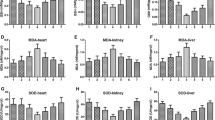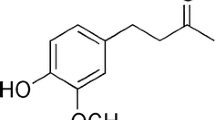Abstract
Alcohol consumption causes the accumulation of reactive oxygen species in liver, which leads to alcoholic fatty liver and hepatocyte injury. In this study, we investigated the effects of an ethanolic Citrus depressa extract and those of its main components on alcohol-induced liver damage using a mouse model. Four polymethoxylated flavonoids, namely, nobiletin, tangeretin, 5-O-demethylnobiletin, and sinensetin, were isolated from C. depressa extract. Treatment of ethanol fed mice with C. depressa extract, nobiletin, tangeretin, or 5-O-demethylnobiletin at 300 mg/kg for 8 weeks by oral administration alleviated the accumulation of lipid droplets in liver and significantly decreased the serum levels of aspartate aminotransferase (AST) and alanine aminotransferase (ALT) (markers of liver damage). Also, in mice treated with ethanol plus nobiletin, tangeretin, or 5-O-demethylnobiletin, liver level of glutathione (an antioxidant) increased whereas levels of tumor necrosis factor-alpha (TNF-α), hepatic malondialdehyde, and hepatic cytochrome P450 2E1 (CYP2E1) mRNA decreased as compared with ethanol fed controls. These findings suggest C. depressa extract and polymethoxylated flavonoids had a protective effect on alcohol-induced liver injury, and that the mechanism involved is related to the regulation of hepatic CYP2E1-mediated oxidative stress.
Similar content being viewed by others
References
Arteel, G. E. (2003) Oxidants and antioxidants in alcohol-induced liver disease. Gastroenterology. 124: 778–790.
Gao, B. and R. Bataller (2011) Alcoholic liver disease: pathogenesis and new therapeutic targets. Gastroenterology. 141: 1572–1585.
Beier, J. I. and C. J. McClain (2010) Mechanisms and cell signaling in alcoholic liver disease. Biol. Chem. 391: 1249–1264.
Rouach, H., V. Fataccioli, M. Gentil, S. W. French, M. Morimoto, and R. Nordmann (1997) Effect of chronic ethanol feeding on lipid peroxidation and protein oxidation in relation to liver pathology. Hepatology. 25: 351–355.
Tripoli, E., M. La Guardia, S Giammanco, D. Di Majo, and M. Giammanco (2007) Citrus flavonoids: Molecular structure, biological activity and nutritional properties: A review. Food Chem. 104: 466–479.
Benavente-Garcia, O. and J. Castillo (2008) Update on uses and properties of citrus flavonoids: new findings in anticancer, cardiovascular, and anti-inflammatory activity. J. Agric. Food Chem. 56: 6185–6205.
Wang, F., J. C. Liu, R. J. Zhou, X. Zhao, M. Liu, H. Ye, and M. L. Xie (2017) Apigenin protects against alcohol-induced liver injury in mice by regulating hepatic CYP2E1-mediated oxidative stress and PPARalpha-mediated lipogenic gene expression. Chem. Biol. Interact. 275: 171–177.
Dzoyem, J. P., A. H. L. Nkuete, B. Ngameni, and J. N. Eloff (2017) Anti-inflammatory and anticholinesterase activity of six flavonoids isolated from Polygonum and Dorstenia species. Arch. Pharm. Res. 40: 1129–1134.
Lu. Y. and A. I. Cederbaum (2008) CYP2E1 and oxidative liver injury by alcohol. Free Radic. Biol. Med. 44: 723–738.
Nyblom, H., U. Berggren, J. Balldin, and R. Olsson (2004) High AST/ALT ratio may indicate advanced alcoholic liver disease rather than heavy drinking. Alcohol Alcohol. 39: 336–339.
Schwabe, R. F. and D. A. Brenner (2006) Mechanisms of liver injury. I. TNF-alpha-induced liver injury: role of IKK, JNK, and ROS pathways. Am. J. Physiol. Gastrointest. Liver Physiol. 290: G583–G589.
Hase, K., M. Ohsugi, Q. Xiong, P. Basnet, S. Kadota, and T. Namba (1997) Hepatoprotective effect of Hovenia dulcis THUNB. on experimental liver injuries induced by carbon tetrachloride or D-galactosamine/lipopolysaccharide. Biol. Pharm. Bull. 20: 381–385.
Wang, M., P. Zhu, C. Jiang, L. Ma, Z. Zhang, and X. Zeng (2012) Preliminary characterization, antioxidant activity in vitro and hepatoprotective effect on acute alcohol-induced liver injury in mice of polysaccharides from the peduncles of Hovenia dulcis. Food Chem. Toxicol. 50: 2964–2970.
Ito, Y., E. Hikiyama, S. Yamada, J. T. Woo, Y. Teruya, K. Sugaya, S. Nishijima, H. Wakuda, and K. Shinozuka (2016) Medicinal composition for preventing or improving dysuria, antagonist against dysuria-related receptor, and method for preventing or improving dysuria using medicinal composition or antagonist. WO Patent 2016075960.
Chen, J., A. M. Montanari, and W. W. Widmer (1997) Two new polymethoxylated flavones, a class of compounds with potential anticancer activity, isolated from cold pressed dancy tangerine peel oil solids. J. Agric. Food Chem. 45: 364–368.
Nagase, H., N. Omae, A. Omori, O. Nakagawasai, T. Tadano, A. Yokosuka, Y. Sashida, Y. Mimaki, T. Yamakuni, and Y. Ohizumi (2005) Nobiletin and its related flavonoids with CRE-dependent transcription-stimulating and neuritegenic activities. Biochem. Biophys. Res. Commun. 337: 1330–1336.
Bertola, A., S. Mathews, S. H. Ki, H. Wang, and B. Gao (2013) Mouse model of chronic and binge ethanol feeding (the NIAAA model). Nat. Protoc. 8: 627–637.
Cardiff, R. D., C. H. Miller, and R. J. Munn (2014) Manual hematoxylin and eosin staining of mouse tissue sections. Cold Spring Harb. Protoc. 2014: 655–658.
Sher, Y. and M. Hung (2013) Blood AST, ALT and UREA/BUN level analysis. Bio. Protoc. 3: e931.
Idriss, H. T. and J. H. Naismith (2000) TNF alpha and the TNF receptor superfamily: Structure-function relationship(s). Microsc. Res. Tech. 50: 184–195.
Meister, A. (1994) Glutathione-ascorbic acid antioxidant system in animals. J. Biol. Chem. 269: 9397–9400.
Hoff, H. F. and J. O’Neil (1993) Structural and functional changes in LDL after modification with both 4-hydroxynonenal and malondialdehyde. J. Lipid Res. 34: 1209–1217.
Mahmood, T. and P. C. Yang (2012) Western blot: technique, theory, and trouble shooting. N Am. J. Med. Sci. 4: 429–434.
Bradford, M. M. (1976) A rapid and sensitive method for the quantitation of microgram quantities of protein utilizing the principle of protein-dye binding. Anal. Biochem. 72: 248–254.
Crawford, J. M. (2012) Histologic findings in alcoholic liver disease. Clin. Liver Dis. 16: 699–716.
Lefkowitch, J. H. (2005) Morphology of alcoholic liver disease. Clin. Liver Dis. 9: 37–53.
Mulvihill, E. E. and M. W. Huff (2012) Protection from metabolic dysregulation, obesity, and atherosclerosis by citrus flavonoids: activation of hepatic PGC1α-mediated fatty acid oxidation. PPAR Res. 2012: 857142.
Lee, Y. S., B. Y. Cha, S. S. Choi, B. K. Choi, T. Yonezawa, T. Teruya, K. Nagai, and J. T. Woo (2013) Nobiletin improves obesity and insulin resistance in high-fat diet-induced obese mice. J. Nutr. Biochem. 24: 156–162.
Akachi, T., Y. Shiina, Y. Ohishi, T. Kawaguchi, H. Kawagishi, T. Morita, M. Mori, and K. Sugiyama (2010) Hepatoprotective effects of flavonoids from shekwasha (Citrus depressa) against D-galactosamine-induced liver injury in rats. J. Nutr. Sci. Vitaminol. 56: 60–67.
Morin, B., L. A. Nichols, K. M. Zalasky, J. W. Davis, J. A. Manthey, and L. J. Holland (2008) The citrus flavonoids hesperetin and nobiletin differentially regulate low density lipoprotein receptor gene transcription in HepG2 liver cells. J. Nutr. 138: 1274–1281.
Mulvihill, E. E., J. M. Assini, J. K. Lee, E. M. Allister, B. G. Sutherland, J. B. Koppes, C. G. Sawyez, J. Y. Edwards, D. E. Telford, A. Charbonneau, P. St-Pierre, A. Marette, and M. W. Huff (2011) Nobiletin attenuates VLDL overproduction, dyslipidemia, and atherosclerosis in mice with diet-induced insulin resistance. Diabetes. 60: 1446–1457.
Choi, B. K., T. W. Kim, D. R. Lee, W. H. Jung, J. H. Lim, J. Y. Jung, S. H. Yang, and J. W. Suh (2015) A polymethoxy flavonoids-rich Citrus aurantium extract ameliorates ethanolinduced liver injury through modulation of AMPK and Nrf2- related signals in a binge drinking mouse model. Phytother. Res. 29: 1577–1584.
Ceni, E., T. Mello, and A. Galli (2014) Pathogenesis of alcoholic liver disease: role of oxidative metabolism. World J. Gastroenterol. 20: 17756–17772.
Kawaratani, H., T. Tsujimoto, A. Douhara, H. Takaya, K. Moriya, T. Namisaki, R. Noguchi, H. Yoshiji, M. Fujimoto, and H. Fukui (2013) The effect of inflammatory cytokines in alcoholic liver disease. Mediators Inflamm. 2013: 495156.
Zhang, A., H. Sun, and X. Wang (2013) Recent advances in natural products from plants for treatment of liver diseases. Eur. J. Med. Chem. 63: 570–577.
Chen, M. F., Y. Y. Zhang, M. Di He, C. Y. Li, C. X. Zhou, P. Z. Hong, and Z. J. Qian (2019) Antioxidant peptide purified from enzymatic hydrolysates of Isochrysis Zhanjiangensis and its protective effect against ethanol induced oxidative stress of HepG2 cells. Biotechnol. Bioprocess Eng. 24: 308–317.
Lee, H., I. S. Suh, M. Woo, M. J. Kim, Y. H. Jung, and Y. O. Song (2019) Beneficial effects of desalinated magma seawater in ameliorating thioacetamide-induced chronic hepatotoxicity. Biotechnol. Bioprocess Eng. 24: 126–134.
Acknowledgments
This research was supported by a grant from the Nakdonggang National Institute of Biological Resources (NNIBR) funded by the Ministry of Environment (MOE) of the Republic of Korea (NNIBR201902105) and by a grant from the Ministry of SMEs and Startups (MSS) under the “Regional Specialized Industry Development Program (P0004934)” supervised by the Korea Institute for Advancement of Technology (KIAT).
Author information
Authors and Affiliations
Corresponding authors
Additional information
Publisher’s Note Springer Nature remains neutral with regard to jurisdictional claims in published maps and institutional affiliations.
Electronic supplementary material
Rights and permissions
About this article
Cite this article
Lee, E.Y., Kim, S.H., Chang, S.N. et al. Efficacy of Polymethoxylated Flavonoids from Citrus depressa Extract on Alcohol-induced Liver Injury in Mice. Biotechnol Bioproc E 24, 907–914 (2019). https://doi.org/10.1007/s12257-019-0310-4
Received:
Revised:
Accepted:
Published:
Issue Date:
DOI: https://doi.org/10.1007/s12257-019-0310-4




